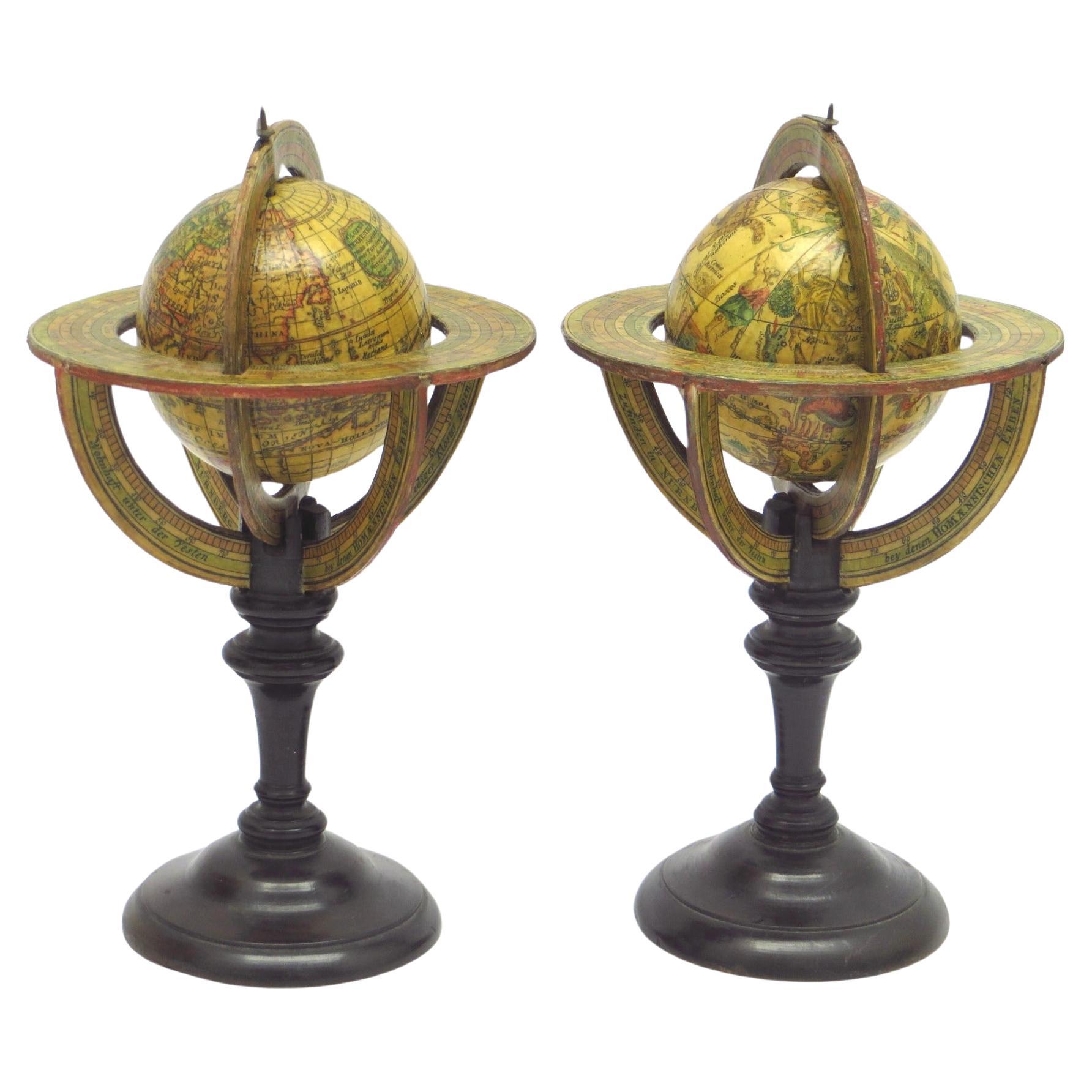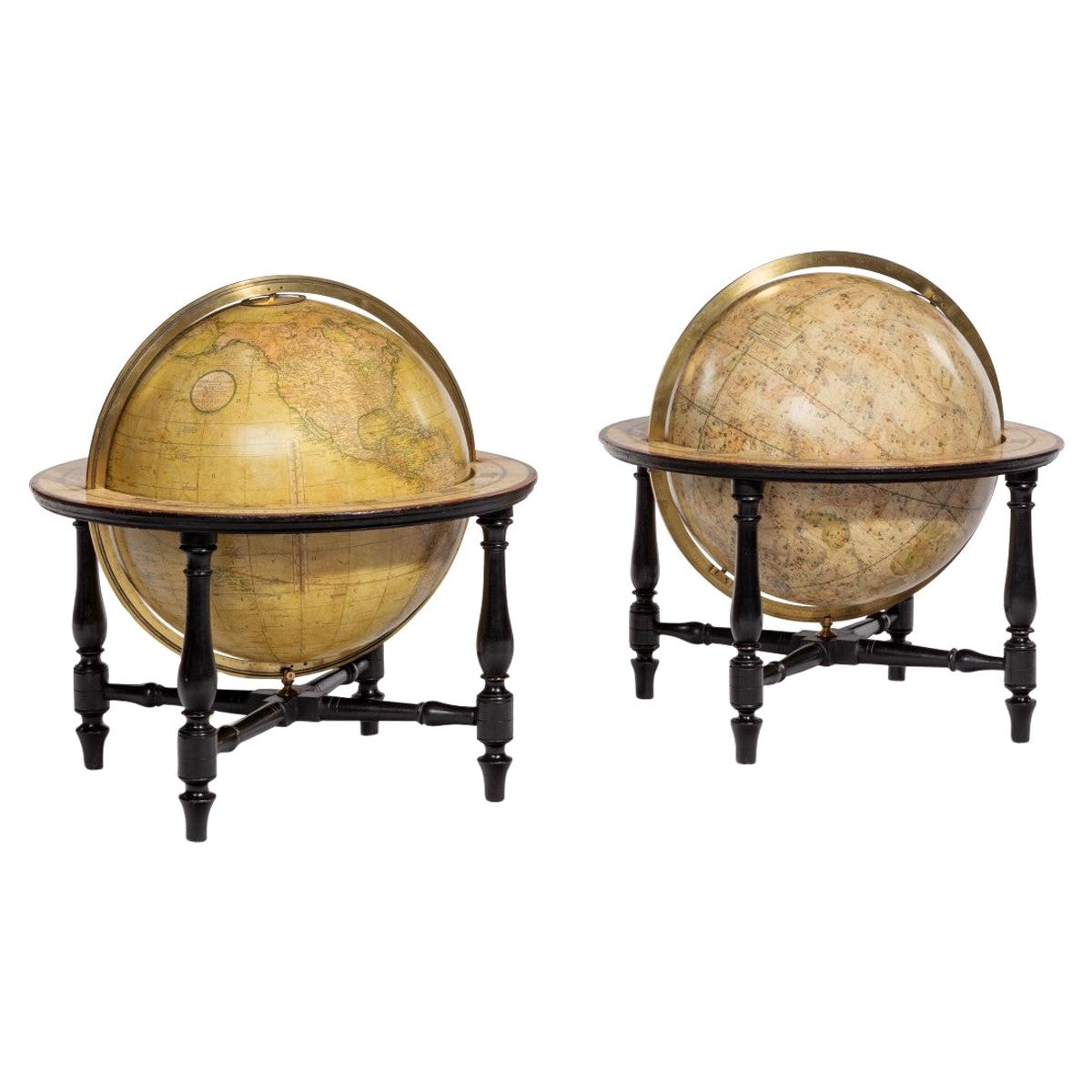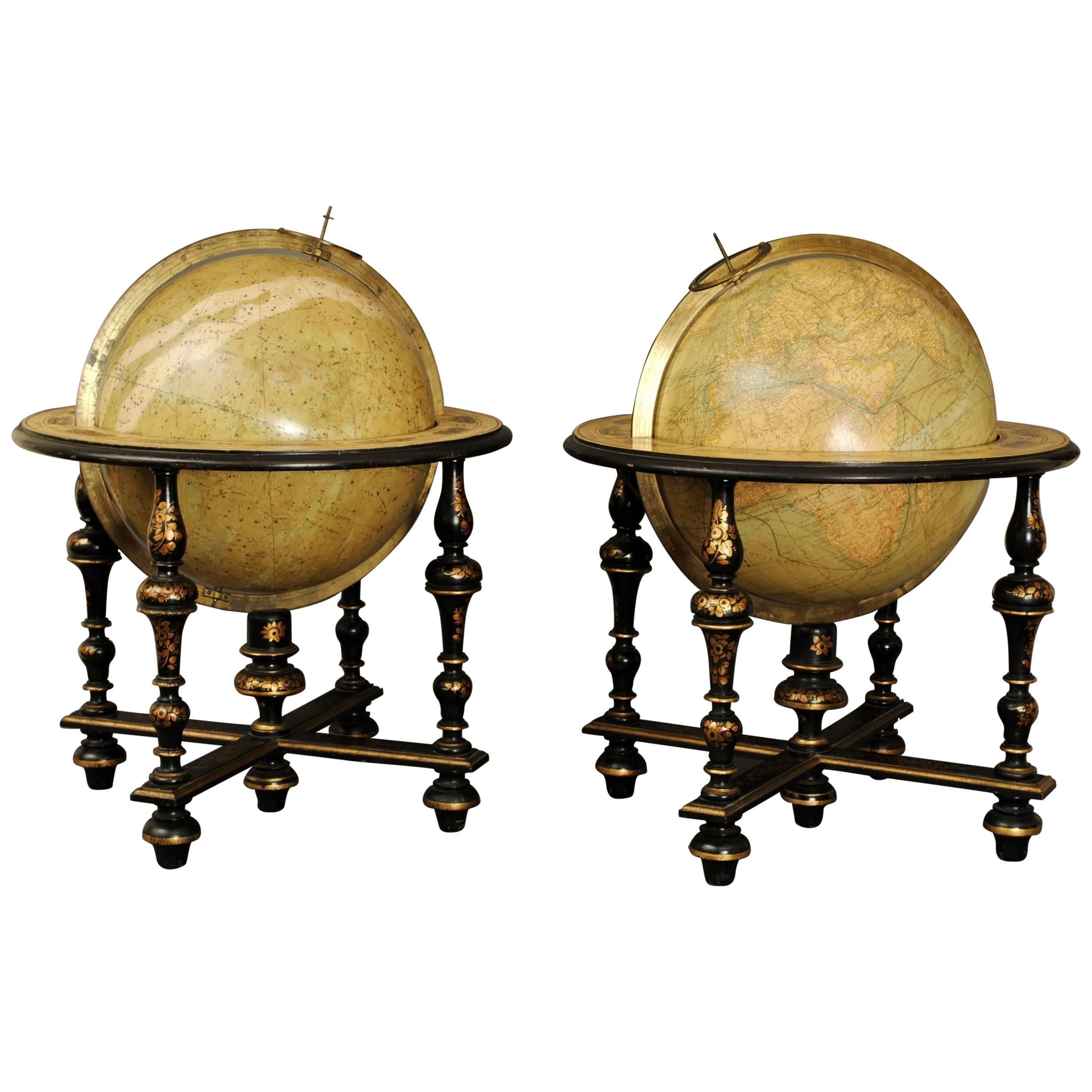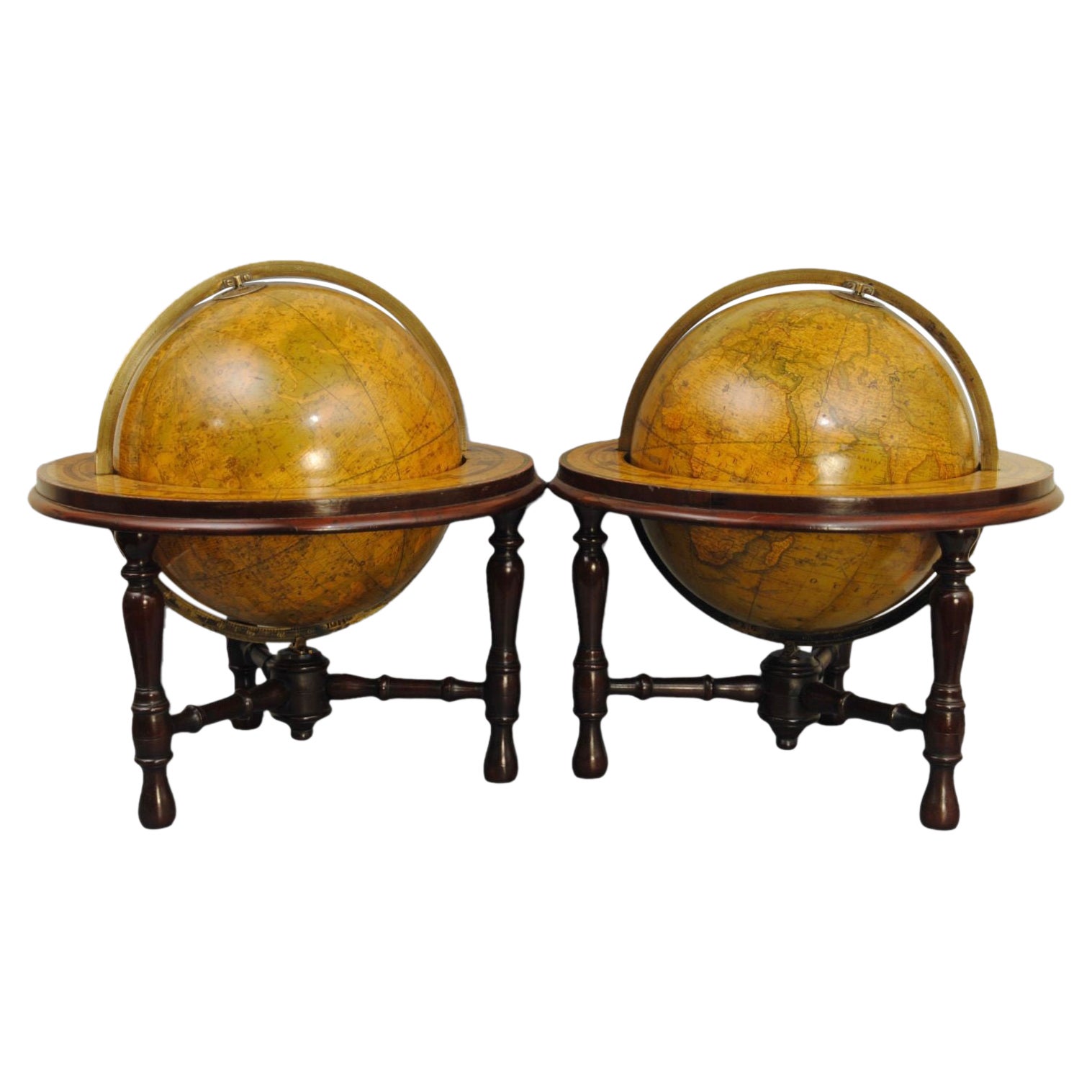Items Similar to An exceptional pair of BLAEU table globes
Video Loading
Want more images or videos?
Request additional images or videos from the seller
1 of 22
An exceptional pair of BLAEU table globes
About the Item
A very rare set of globes, 9 inch / 23cm, with an overall height of 38 cm, Amsterdam, dated 1602, but published after 1621. In their original stands with circular wooden horizon rings, covered with printed paper, supported by four legs and brass meridian rings supported by a single column.
The terrestrial and celestial globe are made up of a set of 12 engraved gores, heightened in gold and Arctic ice caps, printed on paper and mounted on a plaster sphere of papier maché. Each sphere is mounted in a graduated brass meridian ring with the production number stamped at the back of the ring. Both globes are mounted on four-legged ebonized oak Dutch stands, which support the horizon ring. The legs are connected by two crossbeams which support a circular base plate with central support for the meridian ring. The horizon rings are covered with printed paper. With usual defects: paper equinoctial tables present gaps that are filled and restored; small splits along gores; several partially deleted entries; on the globe, the date 1602 and the text of the cartouche in America, are illegible ; small scattered spots but in general in good condition for such an early globe pair of which presently only 19 pair are recorded.
These 9-inch globes are among the rarest since very few copies of them are known to exist, in comparison with the smaller or larger globes of Blaeu (4, 6, 13.5, and 26 inches). Blaeu's terrestrial globes were highly valued and were much in demand, because of the care with which they had been prepared, because of the efforts to give the latest information on discoveries, and because of the loxodromic lines that made them of special value to navigators.
His celestial globes were appreciated for the fact that he had been the pupil of Tycho Brahe, who was himself known to be the greatest astronomer of his time.
Willem Janszoon Blaeu (1571–1638), originally trained in astronomy, he quickly became a leading maker of maps, atlases and instruments. Blaeu’s globes were luxury items for wealthy and intellectual merchants and nobility who benefited from Blaeu’s access through the Dutch East India Company to the latest navigational discoveries and geographical information.
Willem Jansz Blaeu collected information that Dutch mariners gathered from around world and brought back to Amsterdam. Crews were instructed to record information about the lands they visited and the skies they saw. Blaeu incorporated these observations in maps and globes. Through his web of contacts and thanks to assiduous research, he was also able to obtain the most recent information about the latest discoveries in the western hemisphere and the South Pacific, where Dutch explorers were particularly active at the time.
Since the globe was published after 1618, Blaeu was able to include the discoveries made by Henry Hudson in his attempt to find a passage to the East Indies. He also included recent Pacific discoveries of the celebrated voyages of Willem Cornelis Schouten and Jacob Le Maire, who both traversed the South Pacific and the Atlantic. The findings of Schouten and Le Maire in the Tierra del Fuego region are also incorporated.
The Strait of Le Maire is drawn and the hypothetical southern continent is labelled “Terra Australis Incognita Magalanica”. Olivier van Noort’s track is drawn and labelled. His route is indicated with a broken line and the words: “Navigationis Olivierij ductus” (several times). There are various decorative features, such as animals on the different continents, many ships on the high seas and allegorical and mythical figures around the cartouches.
The nine-inch globe is not just a smaller version of the one published in 1599. Drawings of animals and people do often correspond to those on the earlier globe, but Blaeu made several significant changes.
- The west coast of North America is drawn differently and the river system of Brazil is altered.
- The hypothetical southern continent is labelled: Terra Australis Incognita Magallanica.
- There are nine ocean names in handsome curling letters: Mare Congelatum, Mare Atlanticum, Oceanus Aethiopicus, Mare Arabicum et Indicum, Mare di India, Oceanus Chinensis, Mar del Zur, Mare Pacificum, Mar del Nort.
- Willem Blaeu, always eager to display the latest discoveries, traced the route of Van Noort’s route with a broken line. The findings of the voyage of Schouten and Le Maire in the Tierro del Fuego region are included, despite the 1602 date (names: Fr. Le Maire, Mauritius, Staten Landt, C.Hoorn, I.Barneveltij).
The following states are known:
Terrestrial
First state: 1602 (no known examples).
Second state, c1618-1621 (no known examples).
Third state: 1602, but c1621 (the present example).
All the states are dated 1602 but the second state must have been published after 1618, since it includes the discoveries of Schouten and Le Maire (1615–1617), but not the name “Blaeu”.
Elly Dekker makes no distinction between the different states. The third state can be divided into states 3a and 3b. All globes have a different production number, some of which are illegible today. This terrestrial nine-inch globe is marked with “fabr. nr. 4”.
Celestial
First state: 1602 (known in a catalogue record but no known example surviving).
Second state: presumably published after 1621.
All 30 known celestial globes are in the second state, as this one, which is marked with “fabr. no. 12”.
Rare: there are 19 recorded pairs, of which 14 are in institutions.
Bibliography
Van der Krogt, Globi Neerlandici BLA III
Dekker GLB0152, GLB0083 (terrestrial) and GLB0151 (celestial).
- Creator:Willem Blaeu (Designer)
- Dimensions:Height: 15 in (38.1 cm)Diameter: 9 in (22.86 cm)
- Sold As:Set of 2
- Style:Dutch Colonial (Of the Period)
- Materials and Techniques:
- Place of Origin:
- Period:17th Century
- Date of Manufacture:1602
- Condition:Repaired: The hour circles are renewed, the space between the gores are filled up at some places, the gold on the compass roses has been complemented. Wear consistent with age and use. In general in good condition for such an early globe pair.
- Seller Location:ZWIJNDRECHT, NL
- Reference Number:1stDibs: LU9419237294302
About the Seller
New to 1stDibs
Joined in the past six months.
No Reviews Yet
Vetted Seller
These experienced sellers undergo a comprehensive evaluation by our team of in-house experts.
1stDibs seller since 2023
- ShippingRetrieving quote...Ships From: ZWIJNDRECHT, Netherlands
- Return PolicyA return for this item may be initiated within 14 days of delivery.
More From This SellerView All
- An extremely rare pair of miniature globes by Johann Baptist HomannBy Johann Baptist HomannLocated in ZWIJNDRECHT, NLJ.H. Homann (Germany, 1664-1724) Nürnberg, after 1715 Globus Terrestris [and] Globus Celestis. juxtu observationes Parisienses Regia Academia Scientiarum constructus [and] juxtu observationes Parisienses Regia Academia Scientiarum constructus. Nuremberg, [after 1715]. Original stands by Homann Heirs, [after 1730]. An extremely rare pair of terrestrial and celestial globes, each with 12 hand-coloured engraved paper gores, over a papier mâché and plaster sphere, each globe with papier mâché meridian ring, mounted on horizon rings with a handwritten number VIII and III on each globe. The horizon rings supported by four quadrants with text "Zu finden in Nürnberg / wohnhaft unter der Vesten / bey denen Homaenischen Erben/ dem Prediger Klöster gegenüber", both globes on a turned single wooden black stand. Diameter 64 mm (2.5 inches), height 185 mm. RARE. Johann Baptist Homann (1664–1724), a German geographer and cartographer. He founded a publishing business in Nürnberg in 1702, and published his first atlas in 1707, becoming a member of the Academy of Sciences in Berlin in the same year. Homann was appointed Imperial Geographer to Charles VI in 1715 and became the most important map...Category
Antique 1710s German Dutch Colonial Globes
MaterialsOther
- A pair of extremely rare Valk table globesBy Gerard and Leonard ValkLocated in ZWIJNDRECHT, NLTitle on the globes: VALK, Gerard and Leonard. [Terrestrial globe:] Cosmotheore, caelesti nostro globo, par, et plane novus, hic terrestris ut existeret, certo scias, errore veterum ...Category
Antique 18th Century Dutch Dutch Colonial Globes
MaterialsOther
- A decorative pair of rare table globes in a fine condition.By Johann Gabriel DoppelmayrLocated in ZWIJNDRECHT, NLThese pair of globes, dated 1730, are original and in fine condition. Title: Globus terrestris novus Loca Terrae insigniora sec. praestant Astron. et Geogr. observationes sistens op...Category
Antique Early 18th Century German Baroque Globes
MaterialsOther
- A beautiful Celestial Table Globe produced by Gerard & Leonard ValkBy Gerard and Leonard ValkLocated in ZWIJNDRECHT, NLA magnificent and very rare early 18th century celestial table globe produced by Gerard and Leonard Valk. Established at the end of the previous ...Category
Antique Early 18th Century Dutch Dutch Colonial Globes
MaterialsOther
- A fine pair of miniature globes on standsBy Karl MullerLocated in ZWIJNDRECHT, NLA rare pair of miniature terrestrial and celestial globes. by K. Müller, 1822 Karlsruhe, Germany Diameter globes: 7 cm. Total high: 14,5 cm. Each with 12 hand-coloured engraved p...Category
Antique Early 19th Century German International Style Globes
MaterialsHardwood, Paper
- Fine double pocket globeBy Carl BauerLocated in ZWIJNDRECHT, NLPublisher: Carl Bauer (Germany, 1780-1857) Place / Date: Nürnberg, ca. 1840 Size: Diameter Globes 6,5 cm. Terrestrial and celestial "Mother and Child" or double globe; the ...Category
Antique 1840s German Dutch Colonial Globes
MaterialsWood, Paper
You May Also Like
- Pair of Cary’s Table GlobesLocated in Lymington, HampshireA pair of Cary’s 15-inch table globes, each set into an ebony stand with four turned legs and stretchers, the terrestrial stating “Cary’s New Terrestrial Globe exhibiting the tracks ...Category
Antique Early 1800s English Globes
MaterialsEbony
- Superb Pair of Delamarche Table GlobesLocated in Lincolnshire, GBA wonderful pair of 19th century table globes by Mansion Delamarche Paris, in superb original condition. The 12" globes in the original lacquered and gilt decorated stands.Category
Antique 1860s French Globes
- Pair of Table Globes by J & W Newton, Dated 1820By John & William NewtonLocated in Lymington, HampshireA pair of 12 inch table globes by J & W Newton, dated 1820, each with 12 hand coloured gores, graduated meridian rings, set within ebonised stands with three turned legs. The terrest...Category
Antique 1820s English Regency Globes
MaterialsWood
- Pair of 19th Century Table Globes by CrunchleyLocated in Lincolnshire, GBA pair of 12" table globes by the well known map maker Crunchley, London. In the original and very smart mahogany stands. Circa 1865.Category
Antique 19th Century English Globes
MaterialsMahogany, Paper
- Pair of Table Globes by G & J Cary, Dated 1800 and 1821By George & John CaryLocated in Lymington, HampshireA pair of 12 inch table globes by G & J Cary, dated 1800 and 1821, each with hand-painted gores, set in mahogany stands with a turned support raised on three feet centred on the comp...Category
Antique Early 19th Century English Globes
MaterialsMahogany
- Rare Pair of Table Globes by Cary, Each Dated 1816By John & William CaryLocated in Lymington, HampshireA rare pair of 9 inch table globes by Cary, each dated 1816. These globes are by John and William Cary and show the geographical and political borders drawn up following the Congress of Vienna. Each one is surmounted by a brass hour circle, within a calibrated full brass meridian, and a horizon band with an engraved paper calendar...Category
Antique 1810s English Globes
MaterialsBrass
Recently Viewed
View AllMore Ways To Browse
Brass Animal Figures Value
Perer Alexander
Maniglia Ottone
Antique Inclinometer
Antique Nikon
Antique Wood Screw Clamps
Brass Seashell Ashtray
Nautical Flag Letter M
Needle Trade Sign
Rms Titanic
Vintage Nautical Other Decorative Collectibles
Harpoon Gun
John Stobart Savannah Prints
Scrimshaw Tooth
Antique Fishing Reels Uk
Nautical Sampson Post Cleats
Nautical Collectables
Vintage Nautical Bell





